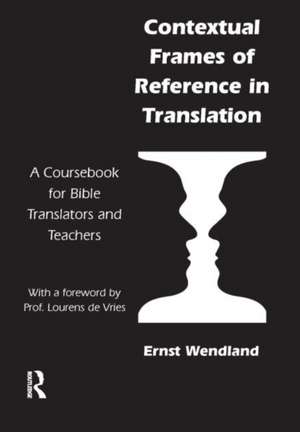Contextual Frames of Reference in Translation: A Coursebook for Bible Translators and Teachers
Autor Ernst Wendlanden Limba Engleză Paperback – 30 mar 2008
A variety of exercises and assignments to stimulate critical and creative reflection as well as to illustrate the theoretical development of Contextual Frames of Reference is provided every step of the way. Not only is translation per se discussed, but the teaching and evaluation of translated texts and versions are also considered from several points of view in the final three chapters. An Appendix offers a foundational essay by Professor Lourens de Vries on the subject of primary orality and the influence of this vital factor in the crosscultural communication of the Bible.
| Toate formatele și edițiile | Preț | Express |
|---|---|---|
| Paperback (1) | 271.20 lei 6-8 săpt. | |
| Taylor & Francis – 30 mar 2008 | 271.20 lei 6-8 săpt. | |
| Hardback (1) | 764.20 lei 6-8 săpt. | |
| Taylor & Francis – 31 ian 2017 | 764.20 lei 6-8 săpt. |
Preț: 271.20 lei
Preț vechi: 325.83 lei
-17% Nou
Puncte Express: 407
Preț estimativ în valută:
51.89€ • 53.54$ • 43.31£
51.89€ • 53.54$ • 43.31£
Carte tipărită la comandă
Livrare economică 27 martie-10 aprilie
Preluare comenzi: 021 569.72.76
Specificații
ISBN-13: 9781905763023
ISBN-10: 1905763026
Pagini: 340
Ilustrații: Illustrations
Dimensiuni: 174 x 246 x 26 mm
Greutate: 0.39 kg
Ediția:1
Editura: Taylor & Francis
Colecția Routledge
Locul publicării:Oxford, United Kingdom
ISBN-10: 1905763026
Pagini: 340
Ilustrații: Illustrations
Dimensiuni: 174 x 246 x 26 mm
Greutate: 0.39 kg
Ediția:1
Editura: Taylor & Francis
Colecția Routledge
Locul publicării:Oxford, United Kingdom
Public țintă
PostgraduateCuprins
Preface 1. Contextual frames of reference: The mind's construction of meaning Analogy of an onion The interaction of frames Prominence, perspective, perceptibility 2. The context of the mind: Cognitive frames of reference Dimensions of world-view: Cultural orientations Cognitive filters Cognitive environment A grid-group perspective 3. Why we do things the way we do: Sociocultural frames The constraint of custom High-context versus low-context communication Mental representations Semantic domains Discerning the fitting frame Gender bias Signs make meaning in context 4. The rights and responsibilities of allegiance: Organizational frames What is an organization? Empowering the organization Competing organizations 5. Situational frames: Communicating in different circumstances A sociolinguistic model: S-P-E-A-K-I-N-G Speech-act analysis Addressing the audience The underlying text of a situational context 6. Textual frames of reference: The pervasive influence of intertext Intertextuality and genre markers Examples of intertextual influence The intertextual pressure of a prior translation Primary versus secondary (and tertiary) translations Which text? The need for textual criticism Textual support of the canon 7. Intratextuality: A text's internal frame of reference Literary hermeneutical clues Genre specification Compositional disjunction Patterned recursion Artistic-rhetorical accentuation Phonic enhancement Formatting the textual form 8. Framing John's vision of the heavenly throne room (Rev. 4) The general cognitive environment of Revelation 4 The ANE milieu of Revelation: Its sociocultural and organizational frames The situational setting of John: Apostle, pastor, prophet The conceptual context presupposed by the throne room vision The formal representation of Rev. 4: Textual frames Co-text: Demarcating the pericope beginning at 4:1 A literary analysis of the text Categorization: What is the genre of Revelation? Articulation: How was the original text proclaimed? Disjunction: How is the discourse demarcated into segments? Recursion: What syntagmatic and paradigmatic patterns appear? Accentuation: How is the text artistically and rhetorically heightened? Varied intertextual notes and chords resound in Revelation 4 (5) 9. Sharpening John's vision for contemporary Chewa text auditors The current communication setting of the text Textual techniques: Contextualizing the translation from within A comparison of versions, old and new (Rev. 4:6b-11) A literary rendition for oratorical equivalence Paratextual and extratextual tools for enriching one's frame of reference 10. Evaluating the overall quality of communication via translation Applying a multiple framework for qualitative assessment Assessing a specific conceptual context of text reception Problems with the powers: A case-study of recontextualization An idiomatic translation of the biblical text The provision of a situation-specific conceptual context The need for a relevant contextualization 11. Framing the text of Revelation 5 for its analysis and translation Identifying the cotext and context of Rev. 5 Analyzing the source language text Providing an appropriate and relevant paratext Specifying, composing, and assessing the translation 12. Creating a contextualized framework for teaching and learning Towards a more setting-sensitive pedagogy Interactive Inductive Indigenized Communal Developmental Comparative Applied The power of dialogue-based, student-centered education A process model for translator training Expanding the teaching-learning context through networking Appendix: Bible translation and primary orality Introduction Primary orality according to Ong Primary orality in transcribed texts from New Guinea Oral genres and Bible translation Conclusion
Descriere
Bible translation theory and practice rightly tend to focus on the actual text of Scripture
